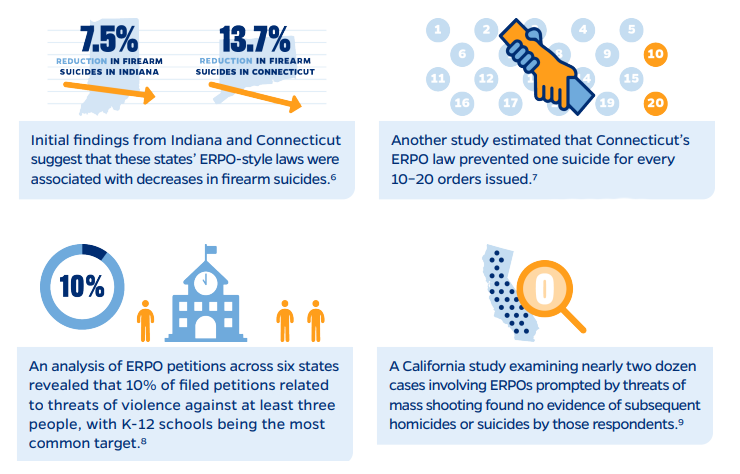New Guide Empowers Leaders to Pass Effective ERPO Laws

The Johns Hopkins Center for Gun Violence Solutions has crafted a new model policy guide to aid policymakers in designing effective Extreme Risk Protection Order (ERPO) legislation.
Research shows the adoption of ERPOs, commonly known as "red flag laws," presents a critical opportunity to mitigate the risks of gun violence. First developed in 2013, ERPOs offer a civil court mechanism to temporarily restrict firearm possession and purchase by individuals deemed a threat to themselves and/or others. The policy is modeled after Domestic Violence Protection Orders, another civil court order used to address credible risks of violence that is available in all 50 states and Washington, D.C. As of August 2024, 21 states and Washington, D.C. have implemented ERPO laws.
Read the GuideExecutive Summary Checklist of Recommendations
The new guide shares 58 recommendations covering 22 different aspects of the policy, offering a comprehensive framework for ERPO legislation. Key recommendations include ensuring due process protections, establishing a standard duration for orders, and creating procedures for firearm relinquishment and compliance hearings. By incorporating these promising practices, policymakers can more effectively safeguard communities from gun violence.
"These recommendations are supported by issue-area experts to make the most effective version of an ERPO policy we can currently envision, regardless of whether a state has passed an ERPO law yet,” says Tim Carey, JD, law & policy advisor at the Center and co-author of the toolkit. “While some of these recommendations are necessary for the law to function properly, the structure of this guide accounts for the variations in law that naturally occur due to differing state practices."
ERPOs function within the civil legal system, allowing law enforcement, family members, household members, and healthcare providers, depending on the state, to petition the court for temporary firearm restrictions on individuals exhibiting heightened risk factors. These orders are typically issued in two phases: an ex parte order, granted without the respondent's presence during a period of immediate threat, and a final order following a court hearing. Such measures aim to swiftly address urgent dangers while upholding due process rights.
While relatively new, ERPOs have demonstrated promising outcomes in preventing both firearm homicides and

suicides. One study indicated that for every 10-20 orders issued in Connecticut, one suicide was prevented. The Center's researchers also analyzed thousands of ERPO cases and identified 10% were issued in response to a threat of mass violence (threats to shoot at least three people). In California, 54% of ERPO cases involved potential interpersonal violence, 15% included a risk of self-harm and 25% involved both.
“The data are clear. ERPO laws are the most effective way to remove firearms from dangerous people,” says Joshua Horwitz, JD, co-director of the Center. “We must make sure these laws are written in the best way possible. This guide will help lawmakers pass policies supported by research and creates a clear guide for proper procedures.”
It’s important to note these policies are also overwhelmingly popular. A 2023 nationally representative survey conducted by the Center found 76% of Americans and 72% of gun owners support allowing family members to ask a court to temporarily remove guns from a relative who may be at risk of harming themselves or others.
ERPOs represent a vital tool in preventing gun violence, allowing those closest to potential violence to stop it before it occurs. By leveraging evidence-informed recommendations outlined in this toolkit, policymakers can enact robust legislation that prioritizes public health and safety while upholding individual rights. Through continued collaboration and innovation, impactful and equitable public health policies like ERPOs can be realized nationwide.




